Energy bars are made for athletes, highly active people, and anyone who needs a quick, energy-dense, and tasty way to increase their calorie intake and their energy availability.
Whether you are on a backpacking trip, doing an ultramarathon, or a fifty-mile bike ride, a high quality energy bar can set you up for success. However, the right energy bar needs to fulfill a few key requirements.
It should have the right kind of energy for your chosen activity, it should be energy and nutrient-dense, and above all, it should taste good.
Need an energy boost in your next workout or on your next trip? We’ve ranked the most effective and best-tasting energy bars on the market.
Research
Rankings
1. RXBAR

RXBAR is an energy bar made only from whole food ingredients. With dates, almonds, cashews, and egg whites, RXBAR delivers a fantastic balance between carbs, protein, and fats.
Each bar has an impressive 12 grams of protein, and the sugar content is around 12 grams, though all of this is coming from dates, not added sugar.
High-intensity athletes like marathon runners might want to opt for something that’s more focused on delivering carbs, but for just about everyone else, RXBARs are the best kind of energy bar for balanced and natural all-day fueling.
2. Picky Bars
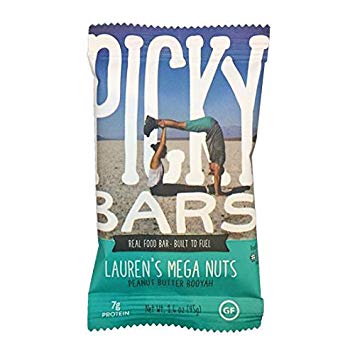
Picky Bars were developed by a team of professional runners who wanted the perfect post-workout snack. They use natural ingredients to deliver a balance between carbs, fat, and protein.
Since it’s geared towards high intensity athletes, the macronutrient distribution tilts towards carbs more so than other energy bars, and the sugar content is high but not overly so, at 15-17 grams per bar. Picky Bars are well-suited for both athletes and adventurers.
3. Redd Energy Bar
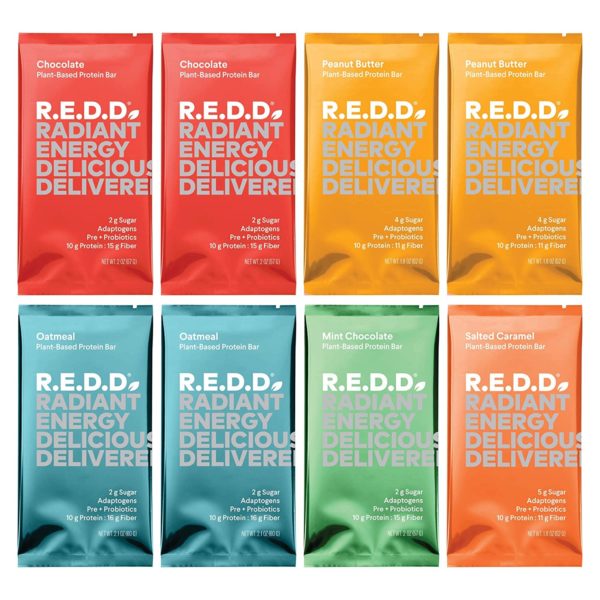
Redd Energy Bars are high-protein, gluten-free energy bars that work well as meal replacements or snacks while backpacking and traveling thanks to their inclusion of a broad range of protein sources, vitamins, and minerals.
With both pumpkin seed and pea protein, each bar has ten grams of protein along with a moderate 14 grams of sugar.
They’re fortified with several vitamins and minerals as well, and the healthy fat content is fairly high, which provides good energy density.
Redd Energy Bars aren’t the best pick for high-intensity exercise, but for many other applications they’ll work pretty well.
4. ZonePerfect Nutrition Bar
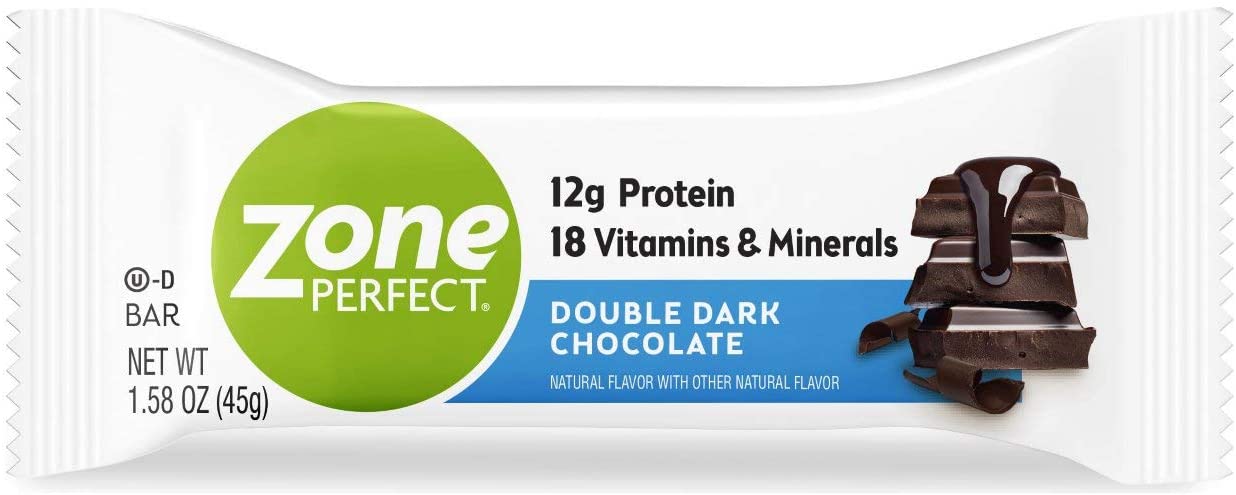
ZonePerfect is something of a cross between an energy bar and a meal replacement bar, but for this reason, it’s a good choice for long outdoor trips.
It has fortified vitamins and minerals that other energy bars don’t have, so if you are travelling and not consistently getting a balanced diet, ZonePerfect can help combat any potential nutrient deficits.
Its high protein content, at 14 grams per bar, is great for sustained energy and recovery, too. The sugar content, at 15 grams per bar, is high but not overly so.
5. Kind Bars
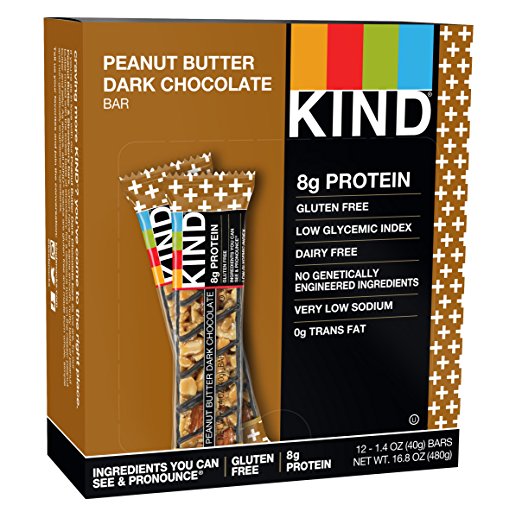
Kind Bars use a natural blend of almonds, peanuts, and chicory root to get a balanced distribution of fats and carbohydrates.
Because there is no concentrated source of protein, they are pretty low in this nutrient: just six grams of protein per bar.
However, thanks to the sweetness added by chicory root, there’s only five grams of sugar per bar. It’s a solid choice if you want a balance of sustained energy between carbs and fats, and don’t need a major source of protein in your energy bar.
6. Greenbelly Meal 2 Go
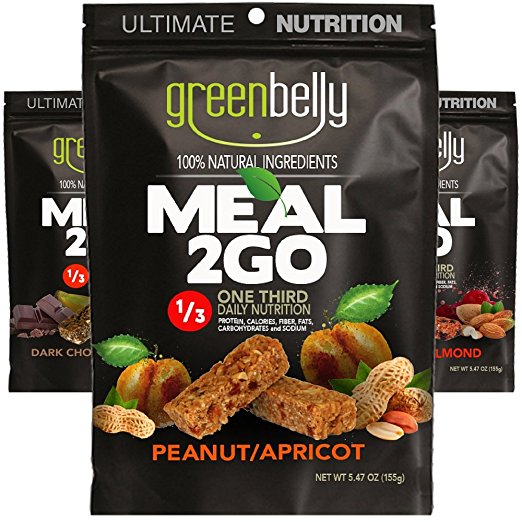
Greenbelly Meal 2 Go was made for long-haul backpackers who plow through thousands of calories per day. Each serving (two bars) is an even split of one third carbs, one third fat, and one third protein.
It’s great for raw energy, but the sugar content is very high. At 35 grams per serving, it’s great if you are forging your way up a mountainside, but far too much if you just need some energy while you’re on the go.
While this energy bar has a very niche application, it does its job well, so if you need energy on your next backpacking trip, it’s a good call.
7. Health Warrior Chia Bars

Health Warrior Chia Bars derive most of their energy and nutrient content from chia seeds. While sugar is the second ingredient, the overall sugar content is actually quite low, at three grams per bar.
Health Warrior Bars are better suited for everyday people who need to refuel on the go, as its actual energy content is not particularly high: each bar only has 100 calories.
This makes it well-suited for the typical day, but poorly suited for backcountry excursions or high-intensity exercise.
8. Clif Bar
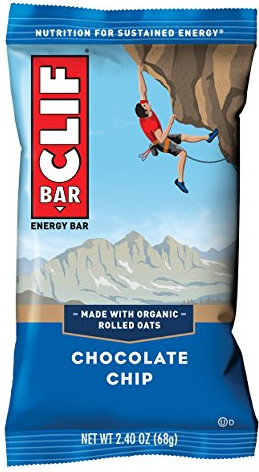
Clif Bars were one of the original top-selling energy bars, but they’ve fallen out of favor in health circles because the current formulation is pretty sugar-heavy. Each bar has 21 grams of sugar, and 45 grams of carbohydrates total.
That’s great if you are doing something with massive energy expenditure, like running a trail race or doing a cycling race, but for moderate intensity long efforts, like backpacking, hiking, or fueling up on the go, the low fat content and fairly modest protein content is not going to be the best pick.
9. Larabar
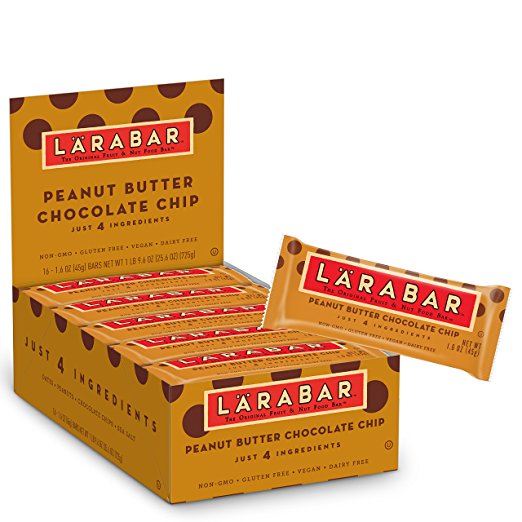
Larabars are all-natural energy bars that are built around a base of dates and peanuts, as well as other natural ingredients that vary depending on the flavor.
They are small, bite-sized energy bars that deliver about a 50/50 split between carbs and fats. The protein content, at 6 grams per bar, isn’t particularly high because there’s no concentrated source of protein, but that won’t be a problem for everyone.
The high sugar content (19 grams) is ameliorated to some extent by the fact that the sugar is derived from the dates, and as such isn’t an added sugar.
10. PowerBar Energize
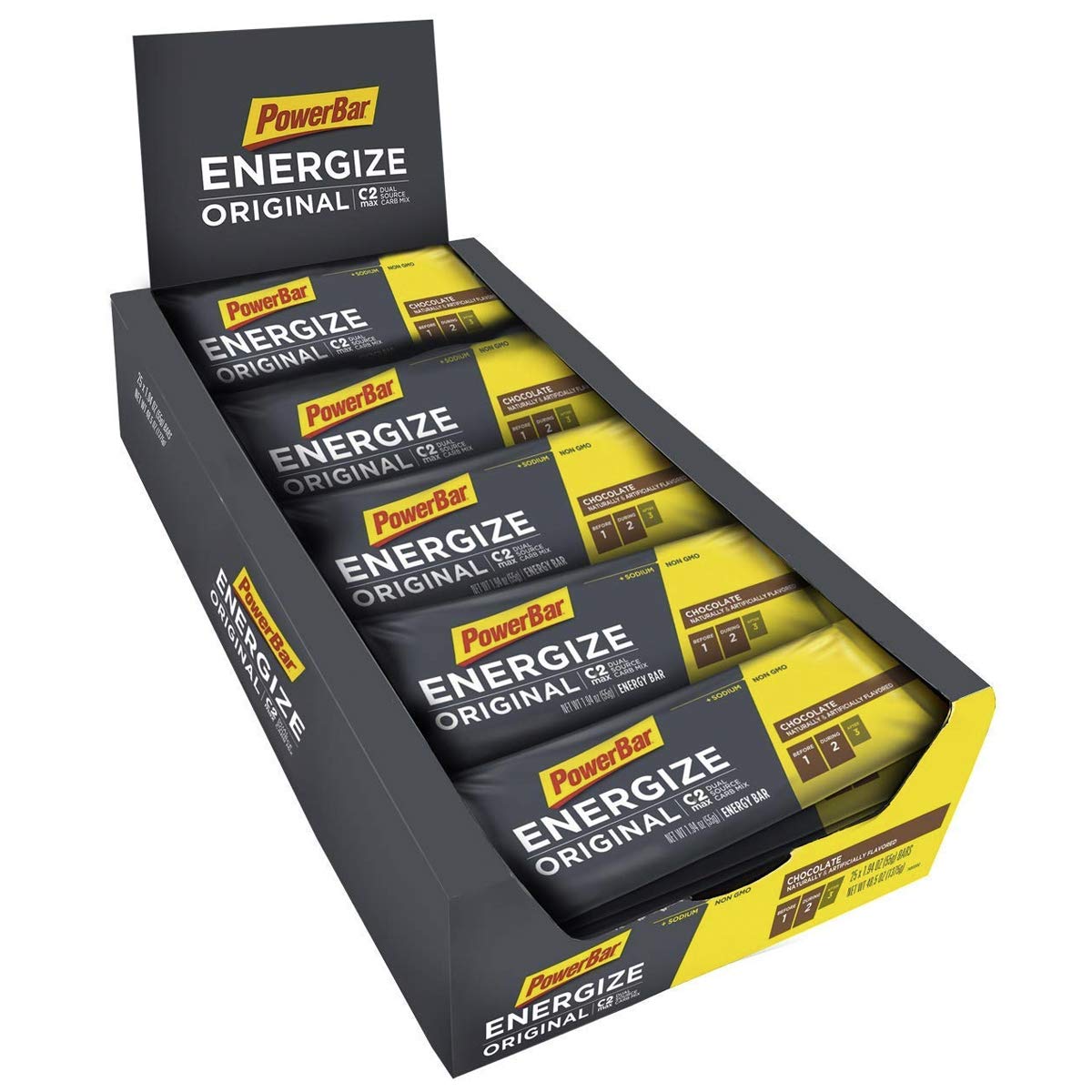
PowerBar was one of the brands that was synonymous with energy bars as a whole. They’re still a heavy hitter, but their energy bar is less well-suited for broad audiences because of its formulation.
PowerBars use a sugar-heavy blend that’s almost devoid of fat and has a surprisingly low protein content of nine grams per bar.
The sugar content is very high, at 26 grams per bar, which is fine if you are doing long bouts of intense aerobic exercise, but could spell trouble if you are just hiking or travelling. While it has its applications, PowerBar is largely outclassed by the competition.
Category winners
Best energy bars overall: RXBAR
RXBAR is our top overall pick thanks to its innovative, all-natural approach that keeps the ingredients list simple, the sugar content under control, and the protein content high. By sourcing all of the ingredients from foods that are as minimally processed as possible, it distinguishes itself from the rest of the competition.
Best energy bars for athletes: Picky Bars
Designed by a team of elite endurance athletes, Picky Bars are geared towards optimal workout recovery while also relying on naturally-sourced ingredients for flavor. They’re excellent for athletes who need to ensure they’re getting optimal energy intake both during and after long workouts.
Best energy bars for weight loss: R.E.D.D. Bar
R.E.D.D. Bar is specifically engineered to keep the protein content high and the sugar content low—that’s exactly what you want in a weight loss energy bar. On top of that, these energy bars are made with all-natural ingredients.
Best energy bars for bodybuilders: RXBAR
For a bump in energy and protein to get you to your next meal, RXBAR is the way to go. The minimalist ingredients and focus on high-quality protein means you don’t have to worry about your energy bars getting bloated with excess ingredients or added sugars.
Best energy bar for the keto diet: Keto Bars
Keto Bars are specially-designed to be keto compatible, with up to 21g of fat and only 3g of net carbs. For high energy density and low carb content, there’s no better option.
Best energy bar for hiking and backpacking: Greenbelly Meal 2 Go
Greenbelly Meal 2 Go was developed specifically for long-distance hikers, so it’s incredibly energy-dense and functions more as a meal replacement than a snack. While the sugar content is high, that’s less of a concern when you’re putting in serious mileage on the trail.
Who should buy energy bars?
Energy bars are great for athletes and gym-goers who need a quick burst of energy to sustain performance during an extended training session. They should not be used as a meal replacement, snack, or an afternoon pick me up. Overweight people should not consume energy bars, as they are often high in calories.
Pregnant women, children, and diabetics should avoid them due to their high sugar content and energy density.
How we ranked
When ranking the best energy bars, the first thing we looked at was the carb and sugar content. We preferred products like Kind Bars and Redd Energy that stayed around 10-20g of carbs and sugar, as we found this was the sweet spot. Products like Power Bars, who had more than 20g of sugar, were ranked lower or axed, as we found this amount to be unnecessarily high. Sugars and carbs that came from natural sources, like dates, were also preferred – which is why Rx bars ranked so highly.
Protein and fats were important to consider, as well. We required a little bit of each of these macronutrients because they’re important for muscle recovery and endurance, but too much often causes slow digestion and an upset stomach. Products like LaraBar, which had around 5-15g of protein, were ranked well.
Lastly, we looked for products with all-natural ingredients. While simple sugars are good for energy, they are bad for overall health. As such, we loved products like Rx Bars that only provided energy from all-natural sources such as fruit and nuts.
Benefits
An energy bar can provide you with the carbs you need to exercise at a high level. When you are exercising intensely, whether this is a prolonged uphill hike, running a marathon, or paddling on an intense river kayaking trip, your body is relying on carbohydrates for the bulk of your energy.
The exercise physiology literature is crystal clear when it comes to fueling during intense exercise: If the session is at least two hours long, there is a major benefit to refueling along the way with carbohydrates.
This is the conclusion of a review article published by Asker Jeukendrup in the scientific journal Nutrition (1). Jeukendrup, a researcher with dozens of studies on carbohydrate metabolism and fueling during exercise, recommends carbohydrate intakes of 50-60 grams per hour during intense exercise.
During extremely long and energy intensive sessions, like running an ultramarathon, some (but not all) people seem able to tolerate carbohydrate intakes of up to 90 grams per hour, but most people should stick to the recommended range.
Sugar is not necessarily bad if you are using your energy bar for intense exercise. Though sugar is often blamed (correctly) for being the source of many health problems, it’s a desirable source of energy if you are doing high intensity exercise.
That’s because sugar’s two constituents, glucose and fructose, can be absorbed in parallel during exercise (2). The rapid spike in blood sugar that results after consuming sugar makes it great fuel for an energy bar used specifically for intense exercise, but a poor choice otherwise.
If you are not exercising, this blood sugar spike is not healthy for your body and stimulates the accumulation of body fat.
Carbohydrate intake is especially important at altitude. If you are a backpacker, mountaineer, or climber, chances are you’ll find yourself at high altitudes on a regular basis.
One of the physiological adaptations to high altitude is a shift to greater carbohydrate metabolism, and as a result, high carbohydrate intake is especially important for peak performance in the mountains. A scientific paper published in the Journal of Applied Physiology demonstrated this effect in a group of subjects who traveled to 14,000 feet elevation (3).
The subjects showed a marked shift away from fat metabolism, particularly in the leg muscles. If you are having lower body fatigue at elevation, low carb intake might be the cause—you should look for an energy bar that’s high in carbs.
Protein in an energy bar can help you recover quicker. Most energy bars have some amount of protein, but the energy bars with the highest protein content work best in situations where you need to recover well after a tough session of activity.
This might be in the form of a post-workout snack after lifting weights, as a recovery meal between legs of a relay race, or as a regular meal on a backpacking trip.
According to a scientific review published in 2004 by Edward Coyle at the University of Texas at Austin, mounting research has found that protein consumed after exercise, especially in combination with carbohydrates, boosts your body’s ability to recover and get ready for another session of exercise (4).
Protein seems to stimulate both muscle repair and increase the uptake of carbohydrates into your muscle fibers, getting them ready for another workout session more quickly.
Protein is not so important during exercise, but it’s critically important for recovery between sessions. Another reason to look for protein in an energy bar is if you plan on using as a meal replacement, but don’t want to opt for a dedicated protein bar.
Fat content in an energy bar is the most energy dense fuel for sustained low and moderate intensity exercise. Not everyone who uses protein bars is an elite athlete who needs to operate at a super-high power output. In fact, one of the biggest groups of people who use energy bars is backpackers and hikers, who need steady and sustained energy all day long.
If you are traveling by foot, you might not need a burst of rapid energy from sugar and simple carbs, but you do need dense sources of energy that last all day long. This is where fat comes in.
According to a scientific article published in the American Journal of Clinical Nutrition by Jeffrey Horowitz and Samuel Klein at Washington University School of Medicine in St. Louis, fatty acids are energy dense but slowly absorbed, which makes them ill-suited for intense exercise but a more attractive option for low-intensity activities that last all day, like walking and hiking (5).
Horowitz and Klein do suggest that MCT oil, in small to moderate amounts, might be a good ingredient to look for, as it can be absorbed more rapidly than longer chain fatty acids.
Pound for pound, fat of any type contains twice as many calories as protein or carbohydrates, which makes it an excellent source of fuel for backpackers and travelers who have to carry their own food. That’s why you’ll see energy bars geared towards these groups that have a much higher fat content.
Recommended intake
The “dosage,” or macronutrient content, of an energy bar is usually dictated by its intended application.
The bars we’ve ranked range all the way from 100 calories each (designed for a snack on the go for fairly healthy people with a normal life) to over 600 calories each (designed for all-day backpackers).
Plan out your calorie needs first, then take a look at your macronutrients to figure out the right energy bar and how often you’ll need to take one.
Something lower intensity but lasting all day will call for a different caloric and macronutrient balance than an intense three-hour bike ride.
FAQ
When is the optimal time to use energy bars? Energy bars are prepackaged foods that are energy dense, easy to eat, and contain the nutrients you need to keep moving. Whether you are traveling, backpacking, riding your bike all day or competing in an ultramarathon, sometimes you need a quick, easy, and energy dense snack.
Can you skip breakfast with an energy bar? You can, but it’s not the best idea. Energy bars don’t have long-lasting energy stores or many of the vitamins and nutrients you require for proper health. Some energy bars may have additional proteins or carbohydrates to let them “sit” in your stomach for longer than others, but they are still not considered meal replacements.
Why am I hungry after eating an energy bar? Energy bars are specifically designed to provide you with food sources that your body can break down and turn into sugar to burn within 30 minutes to an hour. They do not contain “slower-burning” foods in most cases.
What sources of energy do energy bars provide? There are three sources of energy and food, comprising the three primary macronutrients: carbohydrates, fats, and proteins. Most energy bars contain between 200 and 300 cal with 20 to 40 grams of carbs, 3 to 9 grams of fat, and 7 to 15 grams of protein.
When you consume food for energy, your body digests and breaks down different food components and macromolecules at different rates, your body is naturally primed to break down carbohydrates first for quick energy, then fat, then protein. Carbohydrates burn much more quickly than the other two types of energy. This is why eating some crackers, or carb-heavy sweets will be satisfying only for a short while before you are hungry again.
How long does the energy from an energy bar last? The energy from a typical energy bar will last for an hour or less if you are physically active. If you are not physically active, you may feel the jitteriness of excessive sugar intake for several hours until it burns off naturally or is swept away by insulin in the blood.
Do energy bars work for men and women the same? Yes, but energy bars usually provide slightly more energy and nutritional benefits (and issues) to women. Women need fewer or the same nutrients than men and can consume less sugar before being overwhelmed, as they are smaller than the average male. Many “women’s” energy bars will be the same formula of energy bar with slightly lower levels of nutrients and calories, except for iron. Some energy bars include a small amount of iron as a fortifying nutrient, which women need more than men, due to their monthly menstruation cycle.
What are energy bars? In a nutshell, energy bars are supplemental foods that are generally comprised of various cereals and other high energy food items that are packaged into an easy-to-consume way. Energy bars are primarily used for short but effective bursts of energy. They are not meant to be used as meal replacements or for long-term energy consistency.
Why would you use an energy bar? Energy bars are a great source of energy if you need a quick boost and want to curb your appetite for about an hour. Runners and other athletes often use them if they don’t want to stop their exercise but can’t afford to sit down for a more substantial meal, especially to give their stomachs time to digest more complex macronutrients.
Are energy bars considered good snacks? No, energy bars are not considered good snacks. Much like Gatorade has been inappropriately adopted as a drink when you want something flavored, energy bars are often consumed as snacks by those who aren’t exercising or who don’t need fast energy. Energy bars are designed to provide a quick burst of calories and energy to the eater. If you don’t burn that energy relatively quickly, it can be transformed into fat.
Eating energy bars while enjoying a sedentary lifestyle will likely result in weight gain over time, even if the bars themselves seem to be “healthier” than pure dessert foods.
When is the best time to eat energy bars? Your body typically has some energy stored while at rest, and it only begins to dip into those energy stores once you have started exercising for some time. After several hours of intense exercise, you’ll find that you hit a “wall” and are suddenly out of energy. This is the perfect time to consume an energy bar, as it provides your body with the quick fuel it needs to continue performing at the same level without having to stop and break down fat for energy.
When should you never consume energy bars? You should never eat energy bars while at rest or at the beginning of your workout. If you eat an energy bar before you dip into your energy reserves, the nutrients within the bar will be inappropriately consumed and at a staggering rate.
While you may still enjoy the benefits of the energy bar over time, they’ll be less noticeable, and you may even get a stomach cramp from eating food right before working out.
The well-known “3 PM slump” is another time not to eat an energy bar. Although you may be tired from the natural dip in circadian rhythm that most people experience, the energy provided by an energy bar is not the right kind for this occasion.
At this time, you feel drowsy because your body is naturally wired for a nap at what would be the hottest part of the day in a human’s natural environment. It has little to do with your actual activity level or energy storage consumption.
What’s the difference between an energy bar and a protein bar? Many protein bars have the same carbs and sugar just like energy bars but in much lower amounts. Instead, they have higher proportions of protein content to facilitate muscle repair and to give you a “fuller” feeling.
This means that protein bars can better act as meal replacements compared to energy bars, especially since they won’t let you feel hungry shortly after consuming them. Even so, you should still try to eat a full meal instead of a protein bar. Most protein bars contain a lot of unnecessary calories that can result in weight gain if you don’t eat them without adequate exercise.
Can energy bars help you stay awake? Yes, energy bars often contain enough sugar to give an adult of regular size and weight a boost in alertness, which is why some people still use them to get over the 3 PM slump. However, energy bars usually don’t contain as much benefit for grogginess as caffeinated beverages, which directly suppress the hormones responsible for making you feel sleepy. Additionally, energy bars taken to remain alert can result in a “sugar crash,” leading to more significant drowsiness down the road.
Why do I feel shaky after eating an energy bar? You might feel shaky after eating an energy bar from all the quick sugar that hasn’t been burned off or cleared from your bloodstream.
Are energy bars healthy for you? Many energy bar brands like Kind or Clif advertise their products as if they’re healthy for you. However, the truth is more complicated. Energy bars can be healthy for you if accompanied by the right amount of exercise and if you consume them at the correct times and in the right amounts. But energy bars are not healthy foods de facto the same way that natural fruits and vegetables are. Also, energy bars can become unhealthy very quickly if consumed inappropriately, and if you don’t burn the energy, they provide via exercise.
What are the most common forms of carbs and protein found in an energy bar? In most energy bars, carbohydrates are delivered through various kinds of sugar. These include glucose, maltodextrin, and fructose. Complex carbohydrates like oats and barley are used for texture and flavor and additional energy that can burn a little longer than some of the simpler sugars.
Protein is typically provided in the form of the whey, which is a lean protein derived from a cheese/dairy waste product. Whey protein is excellent for energy and muscle building, though the amount of protein in an energy bar is nowhere near the amount needed to act as a workout supplement. Most of the fat in energy bars come from various flavorings like dark chocolate and cocoa butter.
When were energy bars invented? The first thing approaching the modern version of the energy bar was created in the 1960s for astronauts. Dubbed “Space Food Sticks,” these bars were developed as snacks for astronauts in need of quick energy that could last for a long time without refrigeration.
Energy bars continue to grow over the following decades and eventually gained a reputation as a natural energy source through the power of advertising and consumer misconception.
Related Articles
Recap
Energy bars are a great way to fuel up, whether that’s while traveling, on a cross-country cycling trip, or a hiking excursion.
Carbohydrates are essential for high-intensity exercise and don’t overlook sugar if you are doing something like running a marathon or climbing a mountain.
For repeated bouts, like multi-day hiking trips, you’ll need more protein, and for all-day energy in a dense package, you want an energy bar that’s higher in fat.
By considering the caloric and energetic demands of your chosen activity or lifestyle, you can find the right energy bar that will keep you firing on all cylinders.
For Bodynutrition’s #1 recommended energy bar, click here.